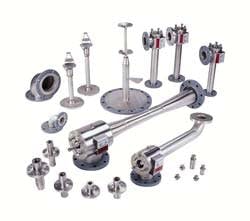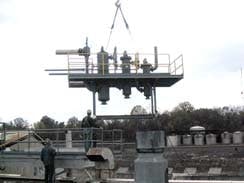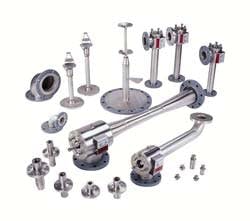Simple maintenance procedures for steam jet ejectors will save time and trouble
- Has lower first and installation costs.
- Needs less water to achieve a given vacuum.
- Allows operation at lower absolute pressure because of a smaller terminal difference.
- Requires less floor area.
- Requires little or no maintenance because scaling or solids buildup has little effect on condenser performance.
- Is readily fabricated from corrosion-resistant materials and can be supplied economically with rubber lining.
- Provides safe operation without atmospheric relief valve because of open barometric discharge.
The surface condenser, on the other hand:
- Permits main condenser condensate to be used as cooling water through intercondensers and aftercondensers, so ejector steam can be returned to boiler to conserve energy.
- Allows recovery of process product as condensate or gas at higher pressure.
- Doesn’t contaminate water.
- Reduces vacuum surges, which may carry water back to the process.
- Requires less headroom than the direct contact type.
The simplest vacuum system to maintain and troubleshoot is an ejector. Because ejectors have no moving parts, maintenance consists of replacing worn nozzles or diffusers, changing gaskets and cleaning condenser tubes. Troubleshooting a large, multistage system sometimes entails disassembly to check each stage and interstage condenser separately. However, very often the internal problem is located in the last or “Z” stage, which is the first to be disassembled.
|
COMMON EXTERNAL PROBLEMS
|
|
TYPICAL INTERNAL TROUBLES
|
Check operating parametersAs a vacuum system ages, problems may arise. A gradual loss of vacuum usually suggests an internal problem — erosion or corrosion — which should be pinpointed on the next routine inspection. A sudden loss of vacuum, on the other hand, suggests external factors, such as a change in quality or pressure of steam supply, or quantity or temperature of water supply to the condensers.Because most unexpected troubles arise from easier-to-investigate external causes, most troubleshooting begins on the outside.The above sidebar, "Common External Problems," provides a checklist.The remedy for these problems is usually fairly simple. For example, if steam quality is marginal, install a separator. Throttle and desuperheat high steam pressure because running an ejector at pressures more than 25% above design will cause a choke in the venturi and decrease capacity.A large cooling water temperature rise indicates insufficient water flow; a small temperature rise indicates excessive water flow and possible flooding. Excessive air leakage upsets system performance so locate and seal major air leaks.Sometimes wet steam or low steam pressure is the result of years of rerouting steam piping as plant operations change. Because an ejector won’t operate well with steam supplied at a pressure below its design point, the steam should come directly from the boiler. If increasing demands for steam throughout the plant make it difficult to maintain design steam pressure to an existing ejector, it may be necessary to re-nozzle the unit, install a lower-pressure ejector, or convert to a hybrid system of ejector plus liquid-ring vacuum pump.Even though an ejector system has no moving parts, it’s wise to inspect internals periodically, and more frequently in difficult services.Have critical dimensions on hand when making the internal inspection. A visual check is usually all that’s required; if steam nozzles and diffusers look smooth and round, you can assume they’re in good shape. If pitting, etching or wire-drawing can be seen, the condition probably has advanced to the point that it affects performance and the parts should be replaced. It’s a good idea to keep spare diffusers in stock for small systems, up to about 6 in. suction, and spare steam nozzles for ejectors of any size.Shiny spares
Troubleshoot stage by stage
An ejector system is always brought online starting from the last stage (the “Z” stage) and working to the first stage. The Y stage can’t operate until the Z stage is operating; the X stage can’t work until the Y is operating, and so on.
To minimize disassembly, perform troubleshooting and testing in reverse order, working backward from the final stage and checking each stage and intercondenser in turn. Fortunately, most ejector system problems are found in the Z stage.
Before starting disassembly, check the Z-stage discharge by looking and listening. If water is coming out of the discharge, the condenser ahead of the Z stage is flooding. A popping noise indicates the stage is not performing properly.
The next step is to check the Z-stage performance. Blank off the suction flange and measure the pressure at the Z-stage suction using an absolute pressure gage. If the attainable no-load suction pressure is above the “as tested” value, disassemble the Z stage and look for clogged or eroded nozzles and diffusers. Most Z stages “blank off” at between 50 mm Hg abs and 75 mm Hg abs.
Next, check the steam chest for indications of leakage, particularly around the nozzle connection. Erosion or corrosion indicate that the diffusers, the nozzles or the preceding stage are probably in poor condition. Isolate the next stage by blanking it off at its suction and repeat the process. Remember, if corrosion or erosion can be seen with the naked eye, the altered clearances affect system performance and the defective part should be replaced. As you proceed through the system, verify that interstage pressures are correct.
Of all the vacuum-producing devices, the steam jet ejector system is the most forgiving. Occasional inspection, replacement of parts and adherence to design conditions will keep it operating reliably for many years. Knowledge of these simple procedures for locating and avoiding trouble will save time and product in your plant.
Henry Hage is vice president for Croll-Reynolds Co. Inc., Westfield, N.J. Contact him at [email protected] and (908) 232-4200 x 109.
Figure courtesy of Croll-Reynolds Co. Inc.


